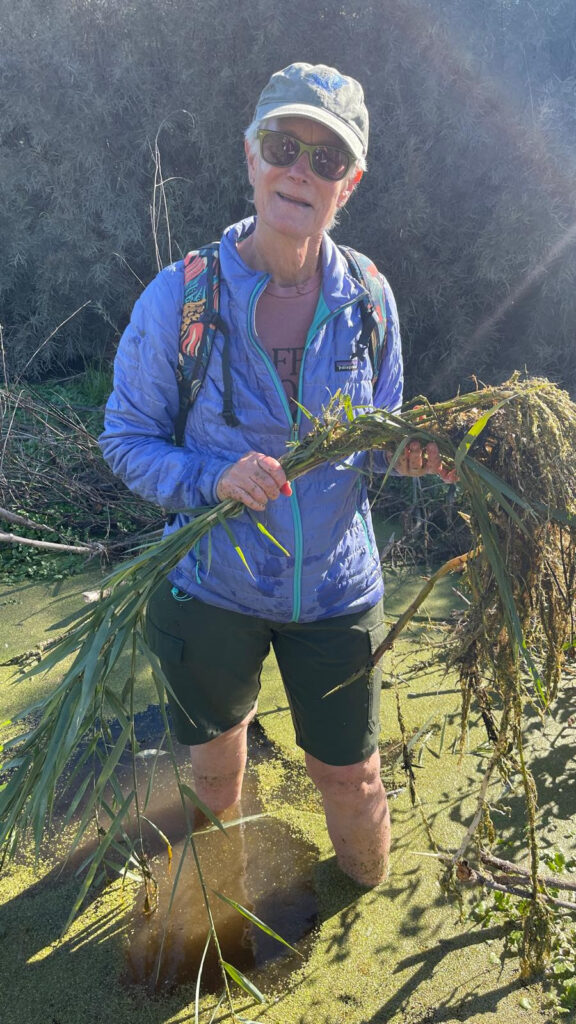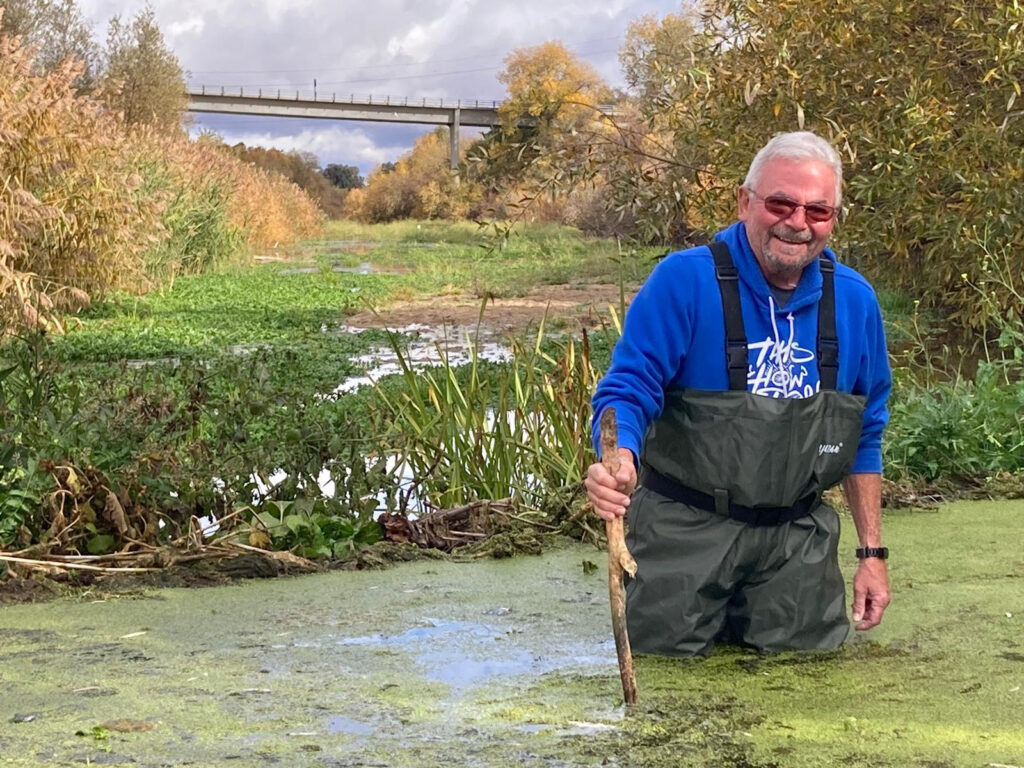Interviewed by Dolores Howard
I first had the joy of meeting Ann and Bill Miller at a SLO Beaver Brigade cleanup. I say joy because this couple is sure to put a smile on anyone’s face, with their kindness, ready-to-help attitude and their love of conversation, beavers and the environment. I instantly realized at that cleanup what a precious gem they are in their “waterhood” (watershed neighborhood). Since then I’ve witnessed them volunteer at many a BB activity. I recently was treated to a beaver dam tour conducted by Ann and Bill – what a lovely experience! I interviewed them a few days ago to find out more about their lives and their roles in the Beaver Brigade. Having a conversation with this warm and friendly couple is wonderful, as they both share enthusiasm for beavers and complement each other in their contributions to the conversation.

DH: Ann and Bill, it’ll be interesting for our newsletter readers to get to know you a bit. Can you tell me about yourselves, your background and what is important to you?
Bill: I have always cared about wildlife and the environment. Beavers are such sympathetic creatures and so when I retired from my role in the environmental enforcement group of the District Attorney’s Office, I found that volunteering with the Beaver Brigade was a natural extension of the work I did before retiring.
Ann: My background is in healthcare so I have always been interested in what people can do to inspire a healthy lifestyle, especially by being outdoors and feeling passionate about something. We lived in Templeton and raised our children there, but had no idea about the beaver dams. Joining the BB has opened my eyes to the beavers in our watershed.
Ann and Bill: Being a part of the Beaver Brigade gives us an opportunity to share what we know with others, family, friends and even people that we just met. Most people in our county don’t know that beavers are here and some might think of beavers as pests. We get to talk about our experiences in the beautiful riparian habitat and people are surprised. We just had a dinner party a few nights ago and we got to share about what we are doing.
DH: Wow, you two are a part of the SLO BB outreach team! Thank you so much! How long have you been involved with the Beaver Brigade and what kinds of BB activities have you participated in?
Ann and Bill: We started with a creek cleanup with Earth Shine in December 2021 and that is when we learned about the Beaver Brigade and the beavers in Atascadero. Then we began joining the BB river and creek cleanups in Atascadero. Since then, our participation has evolved. We’ve done some invasive Phragmites removal and we’ve helped at both Beaver Festivals. Our interest was really sparked by the Beaver Brigade Watery Walk that we did by the wastewater treatment plant and De Anza trail. Then the BB fundraiser that took place at Castoro Cellars was when we really realized all of the benefits that beavers bring to our communities – protection from droughts and fires, recharging groundwater, and creating habitat. The presentations by Dr. Emily Fairfax and Cooper Lienhart had a big impact on us. Now, we monitor the dams in Templeton once a week and we’ve deployed a webcam to record the nocturnal activity of the beavers.
DH: I have seen some footage from those webcams that you’ve shared with other volunteers and there are some amazing images there. I’m going to ask you more about your volunteer work at the Templeton dams, but first, why did you decide to become a beaver dam monitor volunteer?
Ann: We wanted to look deeper into our community and get to know the people in our community. And so, we have found a community of volunteers with a mutual fascination for wildlife and a desire to improve our watershed through cleanups and other activities. As a result, we’ve learned about the Salinas River and how beavers help with two important issues – fire and water, both important issues here in California. So our conversion to being beaver dam monitor volunteers was a natural progression of our involvement. We wanted to “get our hands wet”, and instead of just talking about beavers, we wanted to be physically involved.

Bill: Audrey (Audrey Taub, founder and Executive Director of the BB) asked us to join the beaver dam monitoring team. We like Audrey and she is very persuasive and dedicated to beavers.
Ann and Bill: As beaver dam monitor volunteers, we have learned more about beavers and their life cycle. Even though we raised our children in Templeton, we hadn’t had this opportunity before to build a meaningful connection with beavers and the Salinas River.
DH: It’s great to hear that you feel like a part of a community and that you’ve had worthwhile learning experiences as beaver dam monitor volunteers. Can you tell me about some of your most memorable experiences monitoring the dams?
Ann and Bill: Definitely it’s been the capture of live video footage. We always see beaver sign by the dams- beaver chew, the channels, the dams themselves, and then more dams, but seeing the video footage shows us how they do what they do at night. They build dam after dam, and if the rains come, and the dams are destroyed, they’ll do it again! Using Merlin to identify the bird species at the dam has been wonderful also. The first time that we used it at the dams, in the first 15 minutes, the app identified 16 different bird species: mallards, great egrets, kingfisher, Phoebes, herons and more! It’s not just beavers at the beaver dams – it’s fish (we’ve seen a lot of fish and we’re seeing them get bigger!), insects, birds, plants, and other animals.
Bill: And the water held back by the dams! Now when I step over the dams, the water (and remember that this river bed is wide) is at least twice as deep as when we first started monitoring the dam some weeks ago.
DH: So many great experiences! So, let me ask you: what do you like about being a beaver dam monitoring volunteer and what are your hopes for your future participation with the BB? What are some needs that you can see?
Ann: I’m excited about what I’m doing now, but would like to be involved in building beaver dam analogues. I would like to know the River more by walking downstream. I want to look for more opportunities to be involved in the community.
Bill: I was glad to hear that the BB will be receiving a grant from the California Department of Fish and Wildlife. I would like the BB to network more with CDFW and local law enforcement, but with an emphasis on educating recreational vehicle users about being less destructive in the River and sharing with people how beavers give us fire breaks and prevent the negative impacts from droughts. When I worked with the DA’s office, we always emphasized education first, working hard to get voluntary compliance, instead of enforcing compliance. It’s really much more effective to use education.
DH: Ann and Bill, it’s been so good chatting with you. I am grateful that the two of you have shared with me how you have evolved into river stewards and how you are looking forward to new ways to take care of the Salinas River. Thank you so much for your time. I’ll see you at the beaver dams!